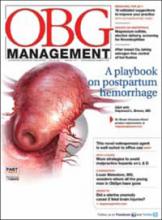“GESTATIONAL DIABETES TESTING GUIDELINES UPDATED”
JANELLE YATES (WEB EXCLUSIVE ARTICLE; JANUARY 2011)
Seeking clarification of new GDM guidelines
I have been following reports of the American Diabetes Association’s (ADA) recently updated guidelines on screening for gestational diabetes mellitus (GDM). None of the reports I have read make it clear what a diagnosis now requires—only one elevated blood glucose value? Two?
And what about monitoring of patients once a diagnosis is made? Has that changed at all?
Nabil Elkhoury, MD
Uniontown, Pa
The editors respond:
According to the guidelines, screening for GDM should take place at 24 to 28 weeks’ gestation using a 75-gram, 2-hour oral glucose tolerance test (OGTT). Plasma glucose should be measured in the fasting state and at 1 and 2 hours. Any single abnormal value warrants a diagnosis of gestational diabetes. The cutpoints are:
- fasting: ≥92 mg/dL (5. 1 mmol/L)
- 1 hour: ≥180 mg/dL (10. 0 mmol/L)
- 2 hour: ≥153 mg/dL (8. 5 mmol/L).
In addition, all women who have risk factors for diabetes should be screened at the first prenatal visit using standard diagnostic criteria. If diabetes is confirmed, these women should be given a diagnosis of overt diabetes, not GDM.
The ADA has not revised recommendations for follow-up and monitoring of women who have GDM. “Additional well-designed clinical studies are needed to determine the optimal intensity of monitoring and treatment of women with GDM diagnosed by the new criteria (that would not have met the prior definition of GDM),” the ADA notes. 1
For more information on GDM, see the May 2010 editorial on the subject by Robert L. Barbieri, MD. It’s available in our archive at obgmanagement.com. Also see the comprehensive overview of GDM by E. Albert Reece, MD, PhD, MBA, that will appear in the March 2011 issue.
“CEASE THE PRACTICE OF EARLY ELECTIVE DELIVERY, SAYS MARCH OF DIMES”
JANELLE YATES (WEB EXCLUSIVE ARTICLE; JANUARY 2011)
Show me the evidence on early elective delivery!
I’d like to see the evidence-based assessment of these repetitive headlines announcing the March of Dimes recommendations. For those of us who actually take care of patients, the likelihood of seeing true serious long-term problems from a delivery at 38 to 39 weeks is incredibly low. In my 20 years of practice I have not seen one. Taking away this option seems without credible basis for those of us who have patients with excellent dating by first-trimester ultrasound. So again I say, show me the evidence that inductions at 38 or 39 weeks’ gestation cause meaningful long-term problems and not just statistical problems such as admission to the special care nursery for observation!
Bret Lewis, MD
Atlanta, Ga
Ms. Yates responds
There are no randomized, controlled trials addressing this question. However, according to the March of Dimes, “Multiple recent studies indicate that elective deliveries <39 weeks carry significant increased risk for the baby (odds ratio, 2.0 to 3.0 compared to infants born between 39 and 41 weeks).”1
In a study of Intermountain Healthcare (Utah and Southeast Idaho), which performs about 30, 000 deliveries each year, the rate of respiratory distress syndrome (requiring a ventilator) “was 22.5 times higher for infants born at 37 weeks and 7.5 times higher for infants born at 38 weeks, compared with infants born at 39 weeks. The study also found increased rates of persistent pulmonary hypertension, NICU admissions and neonatal stays beyond 5 days in a <39-week elective induction group.”1
Other data are provided in the March of Dimes report, Toward Improving the Outcomes of Pregnancy III. 2
“THE UBIQUITOUS, DRAWN-OUT, ANNOYING WAIT TO SEE THE DOCTOR”
ROBERT L. BARBIERI, MD (EDITORIAL; DECEMBER 2010)
7 more ways to reduce the patient’s waiting time
I appreciate Dr. Barbieri’s suggestions for ways to decrease the “drawn-out” wait to see the doctor. Here are seven more strategies for reducing that time that have proved to be helpful to me:
- Follow a template. I have a template that requires me to see an obstetric patient on the 15- and 45-minute marks of every hour. I see gynecologic patients on the hour and half hour, with a break for problem additions to the schedule.
- Designate a time for add-ons. I use the first 30 minutes of each office day to see add-ons floated from nursing calls the night before.
- Forget lunch! I book consults to run through the lunch hour so that I can talk all I want.
- Check the schedule in advance. I check mine 7 days in advance, always scanning for errors or tight scheduling. I sometimes move chatty patients to a looser time slot to maintain flow and avoid errors.
- Use email. I maintain email contact with patients to prevent silly visits that do not require a trip to the office.
- Look at every chart. I examine patient charts prior to the start of office hours and flag things that require extended set-up so that I can give the staff extra time to complete it.
- Apologize for being late. It sometimes can’t be avoided—but when patients are rarely required to wait, they tend to be more understanding when it does happen.


